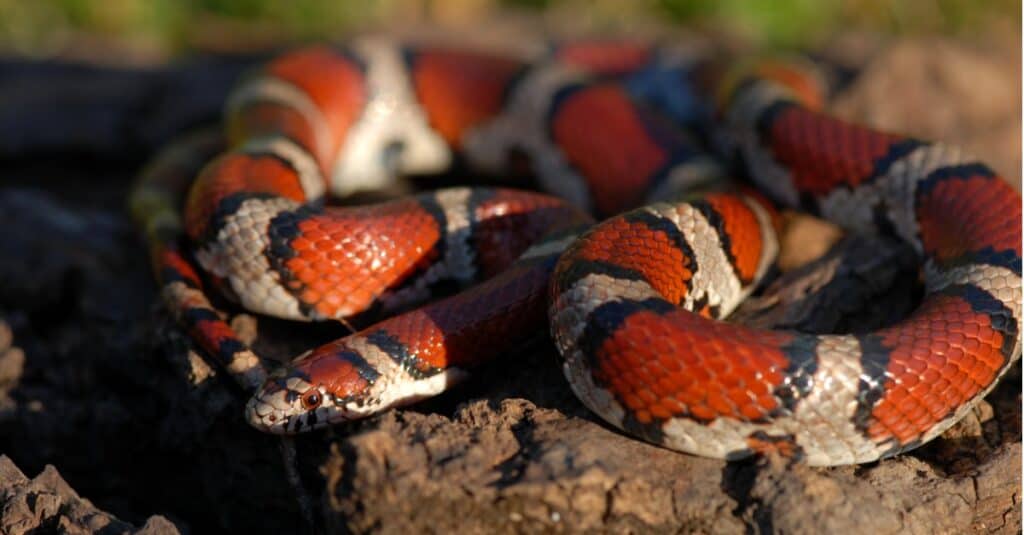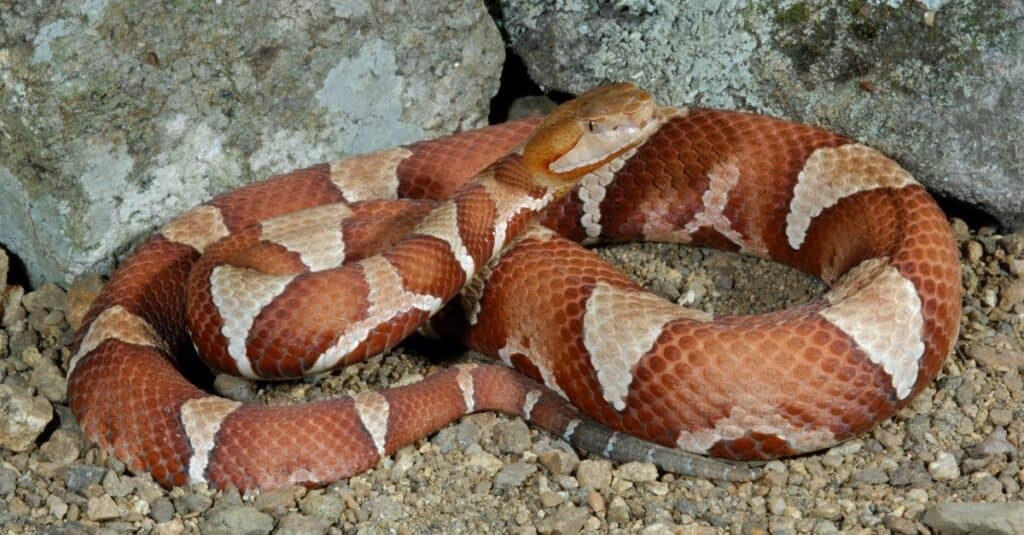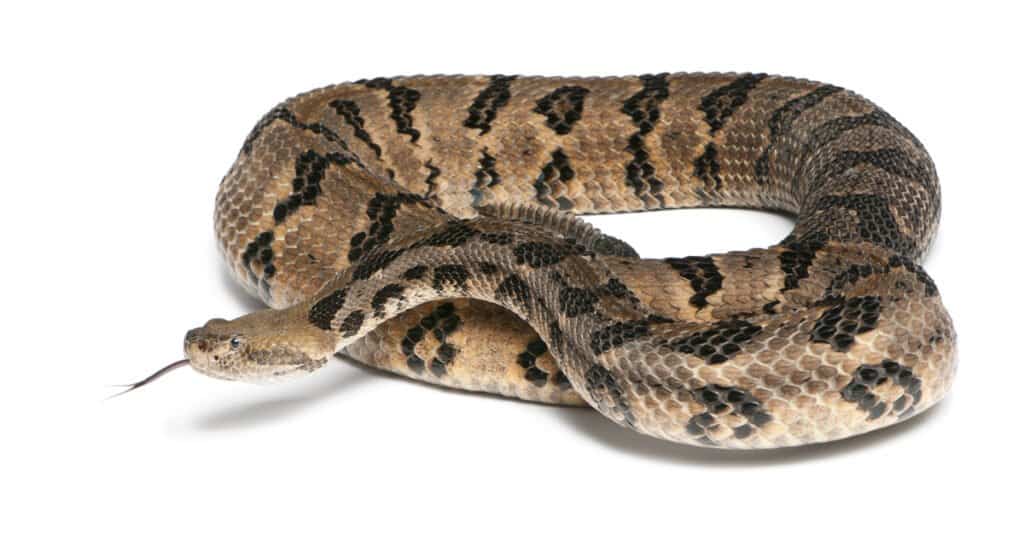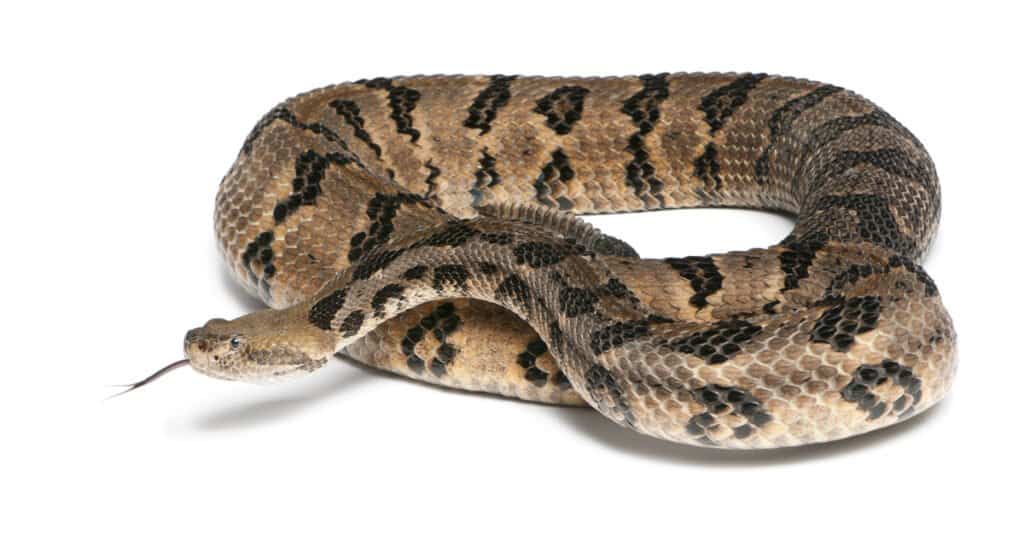Discover the 42 Snakes In Kansas (5 are Venomous)
#mobileSnakeQuizControls { overflow: hidden; text-overflow: ellipsis; white-space: nowrap; }
@media (min-width: 481px) {
.mobile-top-content {
display: none;
}
}
#mobileTopContentCTACarouselControls { overflow: hidden; text-overflow: ellipsis; white-space: nowrap; }
.mobile-top-content .more { color: #fff; }
.mobile-top-content a { color: #fff; text-decoration: underline; }
.mobile-top-content a:hover { color: #fff; text-decoration: underline; }
@media (max-width: 480px) {
.mobile-top-content {
background-color: #06a10b;
color: #fff;
text-align: center;
/*height: 60px;
padding-top:5px;*/
font-size:80%;
/* display: block; */
margin: 0px -30px;
}
}
If you live in Kansas you share your state with many different types of snakes. Kansas is home to more than 40 varieties of snakes. There are 42 different types of snakes that you could come across in Kansas, but only a small portion of them are venomous. Most of the snakes that you will see in Kansas won’t hurt you. If you’re an avid outdoor enthusiast and you like to hike, camp, hunt, or do other outdoor activities from March through about November you’ll likely come across some snakes during their months of peak activity. Let’s dive into snakes across The Free State!
The Most Common Snakes in Kansas
Even though Kansas has a lot of different types of snakes there are only a few that can be found in large numbers throughout the state. Ten types of snakes in Kansas are threatened or in need of added conservation, so you won’t usually come across those snakes unless you are in very specific parts of the state. The most common types of snakes in Kansas are:
Eastern Racer

Matt Jeppson/Shutterstock.com
button.pulse {
transform: scale(1); animation: pulse 2s infinite;
box-shadow: 0 0 0 0 rgba(11, 247, 25, 1);
}
@keyframes pulse {
0% { transform: scale(0.90); box-shadow: 0 0 0 0 rgba(11, 247, 25, 0.5); }
60% { transform: scale(1); box-shadow: 0 0 0 15px rgba(11, 247, 25, 0); }
100% { transform: scale(0.90); box-shadow: 0 0 0 0 rgba(11, 247, 25, 0); }
}
The eastern racer is one of the most commonly seen snakes in Kansas because it likes to inhabit the brush on the prairie as well as grass clumps and other obstructions. In suburban areas or farming areas these snakes are often found in trash piles, burn pits, and hay piles. The Eastern Racer is an extremely fast snake and usually if it feels threatened it will get out of the area as fast as it can. But if it feels cornered it may strike and bite.
Northern Water Snake

jmarino/Shutterstock.com
The northern water snake is a snake that is frequently found in the many rivers, lakes, and streams that flow throughout Kansas. This snake is usually varying shade of gray and brown and may look like a water moccasin. Even though this type of snake is not venomous, it does bite when it feels threatened or provoked. So if you’re kayaking, fishing, or swimming and you see one of these snakes, give it a wide berth. It won’t kill you but it can give you a pretty painful bite.
Plains Milk Snake

iStock.com/Shoemcfly
The plains milk snake has a very striking appearance that looks scary, but this is a non-venomous snake. You can tell a plains milk snake by the distinctive bands of red, yellow, and black. It’s generally found in open prairies and in forests so if you are hiking keep your eyes open. It also is usually more active when the temperatures are warm in July and August.
5 Venomous Snakes in Kansas
Even though there are only four venomous snakes that are found throughout Kansas you should always be on the lookout for these snakes and be very wary if you see one. Remember that if you are bitten by a snake you need to get medical attention right away. Snake bites are rarely fatal but they can cause serious damage to your body.
Cottonmouth

Jay Ondreicka/Shutterstock.com
Cottonmouth snakes are not commonly found anywhere in Kansas except in the southeastern part of the state. These dull colored snakes may not look harmful but they are venomous so avoid them whenever possible. Reports of cottonmouth snakes in Kansas are rare, so its unlikely you’ll encounter one in the state.
Copperhead

Breck P. Kent/Shutterstock.com
Copperhead snakes are the most common venomous snake in Kansas. Every litter of Copperheads can contain up to 14 snakes, so from August to October be on the lookout for any baby copperheads when you’re working or playing outdoors! Some people have even been surprised to find litters of baby Copperheads in their mulch or near planters, so it’s best to stay on your guard when you’re doing any outdoor work during the fall. Copperheads are mostly found in the eastern half of Kansas.
Timber Rattlesnake

Eric Isselee/Shutterstock.com
The timber rattlesnake is a shy snake and usually will hide or flee rather than attack. However, if the snake feels threatened or is cornered it will attack. The Timber Rattlesnake is the most deadly of the venomous snakes in Kansas so if you do see one you should leave it alone. The snake lives in the Eastern side of the snake, mostly in counties near the Missouri river.
Prairie Rattlesnake

Nina B/Shutterstock.com
The prairie rattlesnake is almost always found in the western half of the state so if you frequently are outdoors in the western part of Kansas look out for the prairie rattlesnake. Like other rattlesnakes the prairie rattler has rings around its tail that make a distinctive rattling sound when it’s agitated. However, the prairie rattlesnake is not usually aggressive. It prefers to flee rather than attack. If you are bitten by this snake you do need to get medical attention right away because it is very venomous.
Western Massasauga

fivespots/Shutterstock.com
The western massasauga is the final venomous snake found in Kansas. They’re smaller than other rattlesnakes found in Kansas, but can also be found throughout most of the state (they’re absent most the western-third of the state). The snake prefers grassy wetlands.
Being Safe Around Snakes
Most of the snakes that you’ll find in Kansas aren’t venomous. But, you should still be careful of harassing or angering a snake. Even the snakes that aren’t venomous can give you or your children a nasty bite.
The best thing you can do to protect yourself from a snake bite is to be aware of your surroundings. In most cases snakes won’t bother you unless you attack them or surprise them or if they feel cornered or threatened. You should know what snakes are active in your area and keep an eye out for them. When you are approaching tall clumps of prairie grass or disturbing rocks be careful because there may be snakes living or hiding in those areas. Always move slowly. And if you do see a snake, don’t attack it. Take a breath and back away slowly. If you turn and leave or back up and give the snake some space the chances are good the snake will just go away.
You should also know that in Kansas you need to have a permit to kill snakes. Getting a permit isn’t expensive, so if you live in an area that has a lot of open land or is known for having a lot of snakes you should get a permit so that you don’t end up getting fined if you do need to kill a snake.
Non-Venomous Snakes In Kansas
Most of the snakes in Kansas are non-venomous. In addition to the non-venomous snakes already mentioned these non-venomous snakes can also be found throughout most of Kansas:
- Eastern glossy snake
- Western worm snake
- Eastern racer
- Ringneck snake
- Western hognose snake
- Eastern hognose snake
- Night snake
- Prairie kingsnake
- Common kingsnake
- Milk snake
- New Mexico blind snake
- Coachwhip
- Plainbelly water snake
- Diamondback water snake
- Northern water snake
- Rough green snake
- Great Plains rat snake
- Western rat snake
- Gopher snake
- Graham’s crayfish snake
- Longnose snake
- Ground snake
- Brown snake
- Redbelly snake species in need of conservation
- Flathead snake
- Plains blackhead snake
- Checkered garter snake
- Western ribbon snake
- Plains garter snake
- Common garter snake
- Lined snake
- Rough earth snake
- Smooth earth snake
Kansas does have some of the most deadly snakes in the U.S. But, they are very rare and they are much more likely to run away than attack. You can peacefully share the great plains and rushing waters of Kansas with the many varieties of snakes that live in Kansas.
Discover the “Monster” Snake 5X Bigger than an Anaconda
Every day A-Z Animals sends out some of the most incredible facts in the world from our free newsletter. Want to discover the 10 most beautiful snakes in the world, a “snake island” where you’re never more than 3 feet from danger, or a “monster” snake 5X larger than an anaconda? Then sign up right now and you’ll start receiving our daily newsletter absolutely free.
More from A-Z Animals
.more-snake-card-image { max-height:140px !important; }
#mobileSnakeQuizControls { overflow: hidden; text-overflow: ellipsis; white-space: nowrap; }
@media (min-width: 481px) {
.mobile-top-content {
display: none;
}
}
#mobileTopContentCTACarouselControls { overflow: hidden; text-overflow: ellipsis; white-space: nowrap; }
.mobile-top-content .more { color: #fff; }
.mobile-top-content a { color: #fff; text-decoration: underline; }
.mobile-top-content a:hover { color: #fff; text-decoration: underline; }
@media (max-width: 480px) {
.mobile-top-content {
background-color: #06a10b;
color: #fff;
text-align: center;
/*height: 60px;
padding-top:5px;*/
font-size:80%;
/* display: block; */
margin: 0px -30px;
}
}
If you live in Kansas you share your state with many different types of snakes. Kansas is home to more than 40 varieties of snakes. There are 42 different types of snakes that you could come across in Kansas, but only a small portion of them are venomous. Most of the snakes that you will see in Kansas won’t hurt you. If you’re an avid outdoor enthusiast and you like to hike, camp, hunt, or do other outdoor activities from March through about November you’ll likely come across some snakes during their months of peak activity. Let’s dive into snakes across The Free State!
The Most Common Snakes in Kansas
Even though Kansas has a lot of different types of snakes there are only a few that can be found in large numbers throughout the state. Ten types of snakes in Kansas are threatened or in need of added conservation, so you won’t usually come across those snakes unless you are in very specific parts of the state. The most common types of snakes in Kansas are:
Eastern Racer

Matt Jeppson/Shutterstock.com
button.pulse {
transform: scale(1); animation: pulse 2s infinite;
box-shadow: 0 0 0 0 rgba(11, 247, 25, 1);
}
@keyframes pulse {
0% { transform: scale(0.90); box-shadow: 0 0 0 0 rgba(11, 247, 25, 0.5); }
60% { transform: scale(1); box-shadow: 0 0 0 15px rgba(11, 247, 25, 0); }
100% { transform: scale(0.90); box-shadow: 0 0 0 0 rgba(11, 247, 25, 0); }
}
The eastern racer is one of the most commonly seen snakes in Kansas because it likes to inhabit the brush on the prairie as well as grass clumps and other obstructions. In suburban areas or farming areas these snakes are often found in trash piles, burn pits, and hay piles. The Eastern Racer is an extremely fast snake and usually if it feels threatened it will get out of the area as fast as it can. But if it feels cornered it may strike and bite.
Northern Water Snake

jmarino/Shutterstock.com
The northern water snake is a snake that is frequently found in the many rivers, lakes, and streams that flow throughout Kansas. This snake is usually varying shade of gray and brown and may look like a water moccasin. Even though this type of snake is not venomous, it does bite when it feels threatened or provoked. So if you’re kayaking, fishing, or swimming and you see one of these snakes, give it a wide berth. It won’t kill you but it can give you a pretty painful bite.
Plains Milk Snake

iStock.com/Shoemcfly
The plains milk snake has a very striking appearance that looks scary, but this is a non-venomous snake. You can tell a plains milk snake by the distinctive bands of red, yellow, and black. It’s generally found in open prairies and in forests so if you are hiking keep your eyes open. It also is usually more active when the temperatures are warm in July and August.
5 Venomous Snakes in Kansas
Even though there are only four venomous snakes that are found throughout Kansas you should always be on the lookout for these snakes and be very wary if you see one. Remember that if you are bitten by a snake you need to get medical attention right away. Snake bites are rarely fatal but they can cause serious damage to your body.
Cottonmouth

Jay Ondreicka/Shutterstock.com
Cottonmouth snakes are not commonly found anywhere in Kansas except in the southeastern part of the state. These dull colored snakes may not look harmful but they are venomous so avoid them whenever possible. Reports of cottonmouth snakes in Kansas are rare, so its unlikely you’ll encounter one in the state.
Copperhead

Breck P. Kent/Shutterstock.com
Copperhead snakes are the most common venomous snake in Kansas. Every litter of Copperheads can contain up to 14 snakes, so from August to October be on the lookout for any baby copperheads when you’re working or playing outdoors! Some people have even been surprised to find litters of baby Copperheads in their mulch or near planters, so it’s best to stay on your guard when you’re doing any outdoor work during the fall. Copperheads are mostly found in the eastern half of Kansas.
Timber Rattlesnake

Eric Isselee/Shutterstock.com
The timber rattlesnake is a shy snake and usually will hide or flee rather than attack. However, if the snake feels threatened or is cornered it will attack. The Timber Rattlesnake is the most deadly of the venomous snakes in Kansas so if you do see one you should leave it alone. The snake lives in the Eastern side of the snake, mostly in counties near the Missouri river.
Prairie Rattlesnake

Nina B/Shutterstock.com
The prairie rattlesnake is almost always found in the western half of the state so if you frequently are outdoors in the western part of Kansas look out for the prairie rattlesnake. Like other rattlesnakes the prairie rattler has rings around its tail that make a distinctive rattling sound when it’s agitated. However, the prairie rattlesnake is not usually aggressive. It prefers to flee rather than attack. If you are bitten by this snake you do need to get medical attention right away because it is very venomous.
Western Massasauga

fivespots/Shutterstock.com
The western massasauga is the final venomous snake found in Kansas. They’re smaller than other rattlesnakes found in Kansas, but can also be found throughout most of the state (they’re absent most the western-third of the state). The snake prefers grassy wetlands.
Being Safe Around Snakes
Most of the snakes that you’ll find in Kansas aren’t venomous. But, you should still be careful of harassing or angering a snake. Even the snakes that aren’t venomous can give you or your children a nasty bite.
The best thing you can do to protect yourself from a snake bite is to be aware of your surroundings. In most cases snakes won’t bother you unless you attack them or surprise them or if they feel cornered or threatened. You should know what snakes are active in your area and keep an eye out for them. When you are approaching tall clumps of prairie grass or disturbing rocks be careful because there may be snakes living or hiding in those areas. Always move slowly. And if you do see a snake, don’t attack it. Take a breath and back away slowly. If you turn and leave or back up and give the snake some space the chances are good the snake will just go away.
You should also know that in Kansas you need to have a permit to kill snakes. Getting a permit isn’t expensive, so if you live in an area that has a lot of open land or is known for having a lot of snakes you should get a permit so that you don’t end up getting fined if you do need to kill a snake.
Non-Venomous Snakes In Kansas
Most of the snakes in Kansas are non-venomous. In addition to the non-venomous snakes already mentioned these non-venomous snakes can also be found throughout most of Kansas:
- Eastern glossy snake
- Western worm snake
- Eastern racer
- Ringneck snake
- Western hognose snake
- Eastern hognose snake
- Night snake
- Prairie kingsnake
- Common kingsnake
- Milk snake
- New Mexico blind snake
- Coachwhip
- Plainbelly water snake
- Diamondback water snake
- Northern water snake
- Rough green snake
- Great Plains rat snake
- Western rat snake
- Gopher snake
- Graham’s crayfish snake
- Longnose snake
- Ground snake
- Brown snake
- Redbelly snake species in need of conservation
- Flathead snake
- Plains blackhead snake
- Checkered garter snake
- Western ribbon snake
- Plains garter snake
- Common garter snake
- Lined snake
- Rough earth snake
- Smooth earth snake
Kansas does have some of the most deadly snakes in the U.S. But, they are very rare and they are much more likely to run away than attack. You can peacefully share the great plains and rushing waters of Kansas with the many varieties of snakes that live in Kansas.
Discover the “Monster” Snake 5X Bigger than an Anaconda
Every day A-Z Animals sends out some of the most incredible facts in the world from our free newsletter. Want to discover the 10 most beautiful snakes in the world, a “snake island” where you’re never more than 3 feet from danger, or a “monster” snake 5X larger than an anaconda? Then sign up right now and you’ll start receiving our daily newsletter absolutely free.







